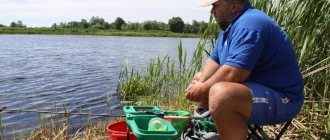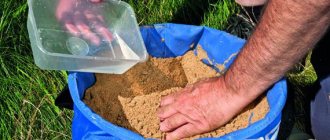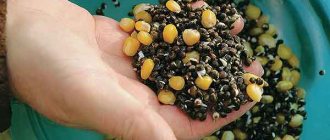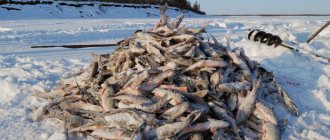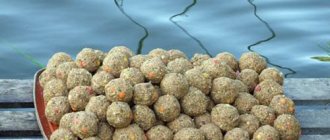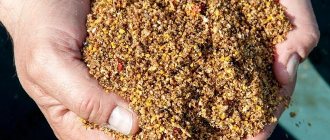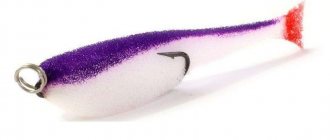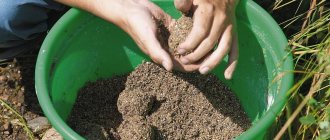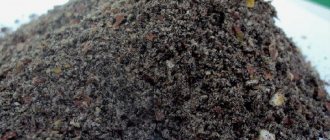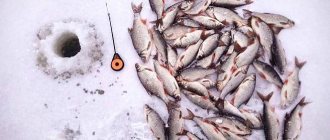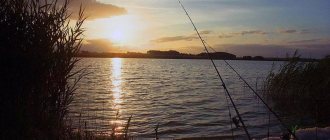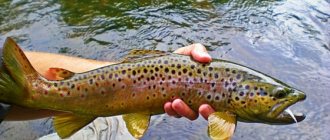Dace fishing
today it is very popular among both novice fishermen and professionals. Dace inhabits rivers and streams with fast and clean water. Sometimes found in flowing lakes. Despite its very modest size (the fish found in our waters rarely reach a weight of 300-350 grams), dace is a desirable catch for any angler, mainly due to the pronounced sporting nature of its fishing. The spotted dace resists so stubbornly that it will do honor to even the more respectable representatives of the ichthyofauna.
Groundbait for dace
Bait is needed to catch almost all types of peaceful fish.
Only predatory fish do not need bait. Bait is also needed when catching dace. At the same time, you need to remember that the dace should only be lured, but not fed, like any other fish. Although, when preparing bait for dace, several other proportions should be followed: 30-40% of the total bait is the bait , and the remaining 60-70% is earth or clay .
The dace immediately reacts to bait thrown into the water, and it is of little interest to the composition of this bait. This means that no special ingredients are required for its preparation. But, as you know, many fishing enthusiasts do their own research and create their own recipes, both simple and complex.
The simplest and easiest to prepare bait consists of white bread . Before use, it should be soaked, after which a dough-like porridge from it is applied to stones, which are then thrown into the water. Bread soaked in water creates a food cloud, and its smell attracts flocks of dace.
Some fishermen pass the bread through a meat grinder along with the seeds. Take one pack of seeds per loaf of bread. Upon arrival at a reservoir, such a dry mixture is mixed with soil and water from this reservoir. From the resulting bait you can roll balls with a diameter of up to 50-100 mm and throw them at the fishing point.
There is another, not bad option. To prepare the bait you need to take 2 plastic bags. Crumble the loaf into one of them, then pour one glass of boiling water into it, and pour peas and millet into the other, then mix them. So, the homemade preparation is ready and you can go fishing. Upon arrival at the pond, you need to find a stone or several stones with a diameter of 5-7 cm. After this, it is covered with a soft loaf and dropped into another bag containing dry peas and millet. They stick to the wet loaf, after which the whole thing is compacted with wet hands. After this, the bait is thrown to the biting point. The bait is slowly washed away by the current and attracts dace.
Another mixture includes breadcrumbs. They should be at least 70% of the total weight of the bait. In addition to them, vanillin, roasted seeds, cocoa powder and milk powder are added to the mixture. Such bait works flawlessly because it creates a huge cloud of turbidity with a bright aroma.
To keep the fish in one place, it is better to add chopped worms or bloodworms to the bait. At the same time, dace should be caught using the same additive (worm or bloodworm). This approach is also relevant when fishing for other fish, not just dace, and any amateur fisherman knows about this.
There is no doubt that this article will help many novice anglers in mastering tactics and strategy when fishing for dace.
What to catch dace with
What to use to catch dace? Dace is one of the common fish often found in our area, and when you catch it you will definitely get a lot of positive emotions.
And even if you are not impressed by the weight of the catch, do not be upset, because this small fish can be used as bait to catch large predators.
By showing ingenuity and patience, you will return home in a good mood and not empty-handed.
Description and habits of dace
Dace is a river fish of the carp family, common in almost all reservoirs of our country. It grows up to twenty centimeters in length and reaches a maximum of two hundred to three hundred grams of weight. For habitat it prefers both rivers and lakes with clean water.
There are as many as seven species of this fish. Outwardly, it is very similar to a young chub, only its forehead is much narrower. Her back is grayish-blue, her fins are slightly yellowish, and her belly is light silver. Dace loves reservoirs with weak currents and a bottom made of sand or pebbles. Prefers to stay in a flock, sometimes gathering in large schools.
Read: Which hooks are best for catching bream?
What to feed the dace?
Many people consider fishing to be a simple activity: you just need to cast a fishing rod and wait for the prey to bite. This opinion is completely erroneous. When going hunting, you should always carefully prepare for the day ahead. There are a lot of techniques, devices and types of baits used in fishing. They directly affect the quality of the process and the catch.
Each type of fish needs complementary feeding and will undoubtedly follow the aroma of a tasty delicacy. You can actually prepare the bait yourself or buy it in a specialized store. You should use bait for dace (and any other fish) wisely and with understanding.
Features of baits for dace
Dace is a rather interesting species of vertebrate. The fish is distinguished by its agility and uncompromising resistance. But at the same time, the fish is not too picky, which makes the fisherman’s task easier. In this regard, do-it-yourself bait for dace should be simple and effective. Once in the water, the bait instantly attracts the attention of the fish and the latter has absolutely no need for exquisite “dishes”.
It is important to understand that complementary foods are not complete feeding, so the product should be offered to the dace along with clay or soil. The approximate amount of nutrients should be 30-40%, the rest is just an addition to the total mass.
The bait mixture for dace must be mixed with soil
The simplest white bread is considered a win-win option for bait. Fish loves the aromatic smell and taste of baked goods. It is enough just to soften the product in water and make balls out of it (or stick small pebbles). You need to throw the bait to the point where you want to concentrate the fish in order to easily catch it in the future.
Some fishermen mix ground crackers with seeds and store the complementary food in dry form, after which they dilute the mixture with water with the addition of earth/clay on site.
After arriving and settling at the fishing site, you need to throw in complementary food in the amount of 4-6 balls made the size of an ordinary apple. You should periodically throw the prepared coma into the water. It is very important to try to keep the fish in the desired location for as long as possible. It is enough to add chopped worms and bloodworms to the prepared complementary food. It is also possible to enhance the aroma with cocoa.
Bait recipes for dace depending on the fishing season
Dace is one of the fish that can be caught at any time of the year. The difference in the process lies in the preparation of the bait. In winter, dace can only be caught at depth and during prolonged thaws. During the cold season, fish welcome almost all types of complementary foods, while in summer dace are very capricious and picky. Autumn and spring are considered the most favorable fishing seasons. This is explained by the fish’s extraordinary appetite; it eats all food particles that fall into the water, and behaves more predictably and obediently.
Depending on the fishing season, it is necessary to select recipes for catching dace
Fishing place
Dace loves fast currents and a hard bottom (usually sandy or sandy-rocky) and usually stays on it throughout the year. In winter, it prefers fast-water holes and other depressions in the bottom. Often found in shallow water rifts. It is generally accepted that dace in cold weather stays exclusively in deep holes and only in the thaw does it go to shallow waters, but I may disagree with this. So this year, at the beginning of January, at a frost of -16...25 °C, dace was successfully caught in the Kostroma region on the Unzha and its tributaries. At the same time, the fishing depth was 1–1.5 m and rarely exceeded 2 m. Elets kept in schools both in the Unzha itself, the width of which at the fishing site was approximately 60–70 meters, and in the lower reaches of its forest tributaries with a width of 10–15 m (one of them is the Knyazhaya River).
On large rivers, including the Oka, in winter it was possible to find dace in fast-flowing ditches located near the shore and on other rapids. Sometimes such fast-water ditches can be found under high steep banks. Of the winter fish, dace is probably the only one that stays in rapids. Usually there are no other small fish near the dace, as it drives them away.
On tributaries, larger dace are most often found in the depressions of the riverbed. The favorite places of this fish can be sharp turns of the riverbed, holes and ditches with fast or medium currents, which are often found closer to the mouth of the tributary.
Alluviums in the form of sandy underwater spits and islands can also serve as a guide when searching for dace in winter. In such areas, it was often possible to find schools of fairly large dace closer to spring on the tributaries of the Rybinsk Reservoir.
On small rivers, when fishing for dace, snagging may occur on obstacles on the bottom.
Dace goes well with both float and jig tackle. This fish can also be caught using combined equipment, including the principle of stepped fishing.
Winter bait
Preparing bait for dace in winter is not difficult. The recipes contain simple ingredients that every fisherman can get. It is important to focus on the season when going fishing, since under certain weather conditions the fish have special preferences and, with inappropriate bait, can bypass the fisherman.
Do-it-yourself winter bait for dace is the best option that will lead to successful fishing.
To prepare a trouble-free delicacy, we recommend using the following recipe:
- You will need two plastic bags, in one of them you should crumble the loaf, then pour boiling water over it. The second bag is filled with crushed peas mixed with millet.
- When fishing, as a rule, pebbles are used, they are covered with a bread mixture and dipped into a bag of peas and millet, making a kind of breading.
The finished balls are thrown into the holes, and they instantly swell. The dace reacts instantly to complementary foods and simply loves this delicacy.
It is recommended to make bait during winter fishing using crackers, seeds, vanillin and cocoa. The use of such a delicacy will help attract a large number of fish due to its pronounced aroma. Cocoa acts on dace like a drug.
Ice dace: bites even in the dead of winter
For catching each fish, there is probably its own best time throughout the year, albeit a very short one. Apparently, only dace should be recognized as an all-season fish, the bite of which can be confidently counted on even in the dead of winter. And in icy water, dace is quick to bite and very active when fishing. But for fishing success you need to know where and what to catch this fish.
Photo: Anatoly Mailkov.
It must be said that dace actively bites in open water, but then the fisherman’s prey becomes mainly small fish and they are found mixed with other fish, mainly bleak and roach, which are very annoying and often tear off and spoil the bait with impunity.
In icy water, many fish lose their former activity and leave the river rapids, and the dace here remains almost alone - even the chub retreats to holes under the rifts.
In winter, the easiest way to find a flock of respectable dace is on small fast rivers, replete with riffles and rocky rapids, because current is the dace’s element in all seasons.
In addition, on a small river, winding among high banks framed by mighty willows and dense bushes, it is easier for a fisherman to find a cozy place where he can hide from winter weather and fish quite comfortably.
The main thing is that the ice on the selected section of the river is reliable, and a fishing pole will help make sure of this, with which the ice cover is first examined, after which they go out onto it with gear and an ice auger. So for river fishing, a good ice pick is necessary even in the middle of winter.
On such rivers, dace feed in the deepest rocky or clayey ditches on the rifts themselves or just below them. But large, fast-flowing rivers, for example, the Oka, are also promising for winter fishing for large dace, because there are always a lot of fish of a respectable size here.
Read the material “Not giving way”
Here, accumulations of dace under the ice are often found very close to the shore, but usually where there is a deep ditch with a hard bottom and strong current running near it, and where this fish again lives in splendid isolation, except that sometimes a gudgeon and a ruffe keep it company, but not competition.
In addition, large dace in cold water often display predatory tendencies and quickly destroy or disperse all small fish. True, on a large and fast river in winter, on rapids, the ice forms in the form of frozen slush, where it is impossible to make a hole, so it is rare to catch dace here.
In winter, as in other seasons, dace, unlike other fish, feeds almost the entire daylight hours, since it spends a lot of energy in the current, so it is very responsive to feeding, especially if the bait contains highly turbid components that give a long trail on the stream.
Such components include powdered milk, egg powder, oatmeal, crushed dry clay - these components must necessarily be included in the bait for catching dace in cold water, while the basis of the bait composition, more than half by volume, is created by carefully ground breadcrumbs .
But the most important thing for the winter dace, what will definitely attract him and keep him at the fishing spot for a long time, is the animal part of the bait, which definitely uses a fair amount, at least a tenth of the entire prepared composition, clean, dirt-free food bloodworm.
Before adding it to bait, it is advisable to freeze it thoroughly and then chop it thoroughly. When thawed in water, such bloodworms will not burrow into the ground, but will give off a long, fragrant trail.
When fishing on the current, it is important that the bait supplied to the fish’s resting place does not quickly wash away, does not satiate the dace, but “gives up” the food gradually. Therefore, the feeder is lowered to the bottom in a hole upstream from the gear and is not opened.
The feed will gradually be washed out through the holes under the influence of the flow. In addition, bait for the current should not be light, for which it is weighted with river sand, fine gravel or the same clay, so that the attracting components do not spread too far and concentrate the fish more densely in the fishing zone.
On a small shallow river, a flock of dace can be attracted differently. To do this, take a long stick and periodically dig through the hole into the bottom soil slightly upstream from the fishing spot. The procedure is repeated as the bite weakens.
Secrets of catching dace
In general, of course, the habitat of dace depends on the season, water temperature, and its transparency. At the very beginning of summer, when the water has not yet warmed up and there is a high level of oxygen in it, schools of dace can be found in the coastal area, in gullies with a calm current and a water depth of about half a meter. For catching dace in this case, the ideal bait would be a dry fly.
In mid-summer, as a rule, the water is already quite warm, so it makes sense to catch dace on the tongue of the drain. To do this, fish a tongue of smooth water with a wet fly; you need to cast it 1-1.5 m above the drain.
And another place where either a large dace or a school of several fish can be found is the area in front of the stone and immediately after it. In this case, a heavy nymph with a tungsten head will come in handy. For more effective fishing, you should move the nymph downstream on a short line, making sure that it touches the bottom, and do not forget to hold the nymph in the most promising places, in your opinion.
The sad fact is that dace, like trout and grayling, are disappearing from most Russian rivers. This is due not only to the fact that there are few places left that are not visited by fishermen, but to a greater extent to the fact that the level of industrial pollution of rivers is very high, and dace loves clean water.
Winter bait options
In reservoirs without a current, bait is poured into the hole and mixed there. After some time, it swells and falls down. For long-term fishing, it is recommended to add the mixture in small quantities. Anglers who have to fish in reservoirs with strong currents need to dilute the bait with sand and water, and when the ball is formed, it must be lowered into the hole. The use of feeders is undesirable because fish are shy in winter, and feeding them can ruin their appetite.
For bream
This fish is very popular among fishermen in winter. After all, even a small bream looks like a big fish compared to roach and perch. And since bream is considered a schooling fish, you can get a good catch if you accurately hit the hole with bait in the hole where this fish is found. If you manage to find a habitat for bream, then you can carry fish throughout the winter season.
Ingredients:
- 250 grams of millet;
- 250 grams of bloodworms;
- 250 grams of corn flour;
- 250 grams of cake;
- 250 grams of crustaceans.
To prepare bait balls you need to do this:
- boil the millet;
- mix flour and cake;
- at the fishing site, add bloodworms and crustaceans to the mixture;
- drop the ball into the hole.
For roaches
As a rule, roach and bream come to bite together. And at the time when the fisherman expects to catch a bream, he comes across small roach. Therefore, making universal bait will serve as a good reason to catch this or that fish. In any case, the catch will be maximum.
The ingredients for creating bait for roaches are as follows:
- 300 grams of corn flour;
- 250 grams of crackers;
- 250 grams of peas;
- 150 grams of fried buckwheat;
- 100 grams of pearl barley;
- 100 grams of anise or hemp, lightly roasted.
When the angler puts bait into the hole, it should be mixed with water and sand and allowed to sit for 10 minutes.
Recipe for roach No. 2:
- 200 grams of roasted seeds;
- 250 grams of orange zest;
- 1500 grams of breaded breadcrumbs;
- 200 grams of millet;
- 50 grams of daphnia or bloodworms;
- some chopped shrimp.
Universal recipes
Recipe No. 1
Well suited for fishing for carp fish.
Ingredients:
- about 1 kilogram of breaded crackers;
- fried seeds, crushed in a meat grinder;
- 200 grams of yellow peas;
- 150-200 grams of oatmeal.
Step-by-step instruction:
- pour boiled water over the peas;
- cook it until it resembles a puree;
- mince fried seeds and oatmeal;
- mix the resulting mass with breadcrumbs;
- near the pond add: a worm, daphnia or finely chopped shrimp.
Recipe No. 2
Ingredients:
- breadcrumbs;
- peas;
- cake;
- oatmeal or millet groats.
Everything needs to be boiled to a mass similar to puree, and then smear the mixture over the feeder on the pond.
Recipe No. 3
Ingredients:
- half a kilo of breaded crackers;
- a spoonful of sunflower oil;
- maggots.
This mixture is suitable as a survey for the presence of fish in a reservoir.
Recipe No. 4
Considered the most difficult.
Ingredients:
- 300 grams of millet;
- 300 grams of bloodworms;
- cocoa;
- orange zest;
- 50 grams of grated chocolate;
- strawberries if desired.
Step-by-step instruction:
- The cereals need to be boiled into porridge, and the rest of the mixture should be mixed into a homogeneous mass.
- It is allowed to add chopped worms to the bait balls.
- At the pond, mix the mixture with soil and lower it into the holes.
Recipe No. 5
Step-by-step instruction:
- cook millet;
- fry breadcrumbs in vegetable oil;
- mix the fried seeds with millet porridge and breadcrumbs;
- add a little bloodworm to the resulting mass;
- Find soil on the pond and mix it with the resulting bait.
How to increase your fish catch?
Over 7 years of active fishing, I have found dozens of ways to improve the bite. Here are the most effective ones:
- Bite activator . This pheromone additive attracts fish most strongly in cold and warm water. Discussion of the bite activator “Dry Blooder”.
- Increased gear sensitivity. Read the appropriate manuals for your specific type of gear.
- Pheromone -based lures .
How to prevent bait from being washed away by the current
Many anglers encounter currents while fishing, especially when using bait to attract fish. It turns out that the bait material leaves a trail of food that floats with the flow. If you use a feeder, you can hold the bait.
After moistening the bait with water, mix it with soil from the pond in a 1:1 ratio.
The bait should be heavy so that it washes out within 5 minutes. This can be done in the following ways:
- weight the mixture with soil;
- add soil to the bait;
- add gravel chips or pebbles, which will help sink the bait faster.
There is a lot of advice in this article, and every angler, whether a beginner or a professional, will be able to learn a lot of new things. Therefore, we wish you successful fishing!
A group of fishermen revealed the name of the secret bait during interrogation.
Where to look for dace in winter
Dace are attracted to fast currents and a strong bottom. In severe frost it hides in holes, and in the thaw it appears in shallow water. The fishing depth ranges from 1 to 2 m. Dace prefers to swim in schools; on large rivers, fish can be found in fast currents close to the shore.
On small rivers and tributaries, large fish can be found in deep places in the riverbed. It can be caught on sharp river turns, in holes with a fast current, which happens near the river mouth.
Excellent places for catching dace in winter are small islands. If you fish for food in small rivers, the fishing rod may cling to the stones at the bottom.
Peculiarities of dace behavior in summer
Fish spawning occurs in the spring; only in the remote northern regions of Russia can it occur in May and early June. This fish itself is not considered large. Typically, the weight of one fish ranges from 200 to 400 grams. In summer, dace feeds on plankton, insects and larvae. Summer is a good time to catch this fish. Dace is one of the first in a reservoir to become active after winter, one of the first to go to spring spawning, and one of the first to sit on a fisherman’s hook with fine-grained bait. Elets prefers to lead a sedentary life, rarely leaving his usual comfort zone. In the morning it can be found near the rifts, and in the evening - at depth. Changes in temperature, poor food supply and pollution of the reservoir can force fish to look for a new habitat. The fish is tightly attached to the house, therefore, even having left it due to natural conditions for several weeks or even months, it will definitely return back when the situation returns to normal.
Read How to tie fishing line on a fishing hook with different knots
Fishing methods
You can catch dace in winter throughout the daylight hours; biting activity is observed in the morning. At the end of winter, fish are also fished at night. The fish bite best in December and February. In winter, dace are caught using a float rod and jig. Fishing with a jig with bloodworm bait is more effective.
In December, you should actively play with bait, thereby attracting fish. Some fishermen fish with a reelless bait, but such bait requires experience and is used for professional fishing. During winter fishing, dace behaves cautiously.
Gear used
The float equipment is formed so that the current does not pull the float down. In this case, the diameter of the fishing line is of great importance. Since the weight of dace is no more than 150 g, you need to use high-quality thread with a thickness of 0.08 mm. Then the float can be close to the surface of the river.
To create the lower rig, a sinker is attached to the end of the thread, and a leash is attached to the thread 20 cm above it; with the bait attached to the hook, it will move from one side to the other, luring the dace.
A fishing rod for dace should have a nod and a jig. In this case, the sensitivity of the nod should correspond to the strength of the river current and the mass of the jig. Fishing with jigs can be active or passive. During active fishing, the rod is held in the hand, and the jig is used to retrieve it so that it bounces and moves.
If the weight of the jig is small and it is carried to the bottom, then you need to lower the tackle a little down and pull with stops. Periodically, the jig needs to be stopped for a longer period; the bite occurs at this time.
If fishing is passive, then the rod is placed on the ice so that the nod, bent under the weight of the jig, is above the hole.
Periodically, the nod needs to be moved, this will cause the bait on the hook to move. In the depths of winter, use dim jigs that can withstand strong currents. The fisherman must prepare several jigs of different colors and shapes in advance; this will allow him to quickly achieve a good bite from active fish.
You can use combined gear. A nod is installed on the rod, which becomes an indicator of the bite, and a float rig with a sinker is attached to the fishing line. Most often, fishermen use an 18 hook with a long shank; its color is selected depending on the shade of the bait.
Catching dace in May with a float rod
Catching dace in May with a float rod does not require any special skills and is accessible to anglers of any skill level.
Tackle for catching dace in May using a float rod
Fishing for dace in May is most often done with a retrieve, so the best gear option would be a light rod with line guides and a reel seat. A Bolognese fishing rod made of carbon fiber meets these requirements. Depending on the fishing conditions, the length of the fishing rod is about 4-6 meters. When fishing for dace in May in small rivers, the movements of an angler with such a rod can be hampered by vegetation, so in such conditions it is necessary to fold 2-3 knees and fish with a 2-3 meter rod.
For catching dace in May, a fly rod with a length of 5 to 7 meters with a blind rig is also suitable.
The Bolognese fishing rod is equipped with a reel, it can be either a wire inertial reel of small diameter or a spinning reel of size 1500 according to the Shimano classification. The main fishing line is monofilament with a diameter of 0.14 to 0.18 millimeters, but experienced anglers can use fishing line with a smaller diameter. The rig contains a fluorocarbon leader with a length of 10 to 40 centimeters.
The thickness of the leader is usually 0.02-0.04 millimeters less than the thickness of the main line. You can take a drop-shaped float with a bright antenna. The carrying capacity of the float, depending on the fishing conditions, does not exceed 5 grams. Loading is done using lead pellets or an olive-shaped sinker. It should be noted that fishing for dace in May in places with shallow depths and moderate currents does not require heavy equipment, so a float with a carrying capacity of 2-3 grams loaded with one “olive” will be quite sufficient. Depending on the type of bait or attachment used for catching dace, hooks of sizes No. 14-18 according to international gradation are selected.
Technique for catching dace in May using a float rod
Having chosen a promising place for fishing and carried out the starting feeding, you can proceed to the fishing process. It is recommended to start fishing 20-30 minutes after the starting feeding, since the dace is most likely frightened by the loud slaps of bait balls in the water.
The dace prefers to stay near the bottom, so we adjust the tackle in such a way that the hook with a worm or other bait strung on it can easily stay at a distance of 3-5 centimeters from the bottom. Thus, the bait, held at the required depth by the float, drifts freely with the current, helping the angler to fish a fairly large area of the reservoir.
Do you need bait?
When fishing for dace in winter, you need to use bait, this allows you to lure the fish to one place. Bait is sold in stores; you need to add water and bloodworms to it. It should be written on the packaging that the composition is intended for winter fishing.
Pieces of food should be gradually washed away by water, otherwise you can overfeed the fish. Fishermen also use homemade bait prepared at home. For bait you need to use crackers, millet porridge, milk, egg powder and about 15% of the total amount of animal food: chopped worms, bloodworms.
Effective baits
Lures for winter dace fishing can be natural or artificial. To catch this fish, it will be more effective to use natural baits: worms, maggots, bloodworms. Jigs should be used as artificial baits.
Artificial
For catching dace in winter, jigs in the form of a drop or a shot are suitable; the diameter of the bait should be no more than 3 mm. In strong currents, tungsten bait is supplemented with lead bait.
Artificial baits and lures for catching dace should be silver in color. The models of jigs used are “ant”, “witch”, “larva”. Fishermen consider the “witch” bait to be the most catchy. In addition to the nozzle, cambrics and beads of different colors are used.
Natural
In winter, the most effective bait is bloodworms or other animal bait. To catch dace, you also need to attach a worm or maggot, or bark beetle larvae. Many fishermen use a combination of bloodworms and maggots; it attracts big fish.
In addition to bloodworms, you can put a cube of lard or a bark beetle larva on the hook. Caddisfly is used as a plant bait.
Float equipment
In the case of float fishing, the equipment should be such that the fast current does not drag the float under water. At this point, the thickness of the fishing line is decisive. Since the mass of dace is usually no more than 150 g and specimens up to 200 g are rarely found, you should use high-quality monofilament with a diameter of no more than 0.08 mm. Even a strong current blows out such a fishing line weakly, and this allows a small float to stay close to the surface of the water. Bottom rigging may look different. Sometimes they pass the fishing line through a sliding “olive” weighing 15 g and stop it with the smallest lead pellet, leaving a leash 15–20 mm long. Sometimes a stationary sinker is attached to the end of the main line, and above it, at a distance of 20–30 cm, a long leash is tied to the line, which will move attractively from side to side with the bait attached to the hook. When choosing the length of the leash and the height of its attachment, the strength of the current is taken into account and the peculiarity of the dace is kept at a level no higher than 5–7 cm from the bottom. Hook No. 18.
Fishing technique and tactics
Winter fishing for dace with a float rod begins with choosing a good area in which holes are drilled with an ice drill. The number of holes corresponds to the number of fishing rods. The holes should be at a distance of half a meter from each other. Pieces of ice are removed from them, then bait is poured in.
After 30 minutes the fish swims to the hole. The fisherman places the bloodworm on the hook and lowers the thread into the water. The float should be located 1-2 mm below the water level. You need to put the fishing rod on the ice and watch the float. Individuals are careful; they first try the bait and then capture it. In this case, the float will tremble a little and move to the side.
You need to carefully hook the dace. Fishing with a nod rig is a more difficult process, because the wind prevents the fisherman from detecting a bite. When fishing with a jig, you need to make 5-10 holes.
It is necessary to drill them along the shore or closer to the center of the reservoir. Bait is poured into the holes, and after half an hour they begin fishing. The bait is placed on the hook and the thread is directed into the hole.
The frequency of oscillations of the jig depends on the activity of the individual. The fisherman gradually lowers the bait down and taps it on the bottom. Then he slowly lifts the bait from the bottom 1 m and stops for 10 seconds, and then lowers the jig to the bottom again. When the bait is tapped on the bottom, the fish bites.
Bait and groundbait
For bait I use maggots, earthworms, and caddis flies.
There are never any problems with maggots and worms; they can be purchased at a fishing store if necessary. But you have to catch the caddisfly yourself. But it's worth it. Dace has great respect for mayfly larvae. A bulky light rag is lowered onto the shallow rocky bottom with the current and checked periodically. We remove the crawling caddis flies and everything starts again. Walking with a clothespin on a stick is somehow uncomfortable.
I’ll be honest - I rarely use bait, and then only when I have to fish from a hole. Rusks ground in a meat grinder with fried seeds, “chicken” porridge with the rare addition of bloodworms. I know that many fishermen specifically buy various baits and fragrant oils in the store.
Read Bloodworm: how to save and hook
But judging by the fact that the bite is not particularly different from mine (and I prefer baitless jigs), I believe that it’s not worth spending extra money on.
And now about the gear. I use a 5 meter long rod. Simple, Chinese. With a plastic inertial reel and a wound monofilament line with a diameter of 0.22-0.25 millimeters. This is regardless of how I fish - with a donk or a float. The most important thing is to set the stage itself with hooks and sinkers.
